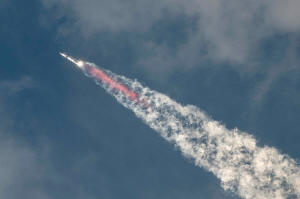SpaceX Starship disintegrates after completing most of third test flight
 Send a link to a friend
Send a link to a friend
 [March 15, 2024]
By Joe Skipper, Steve Gorman and Joey Roulette [March 15, 2024]
By Joe Skipper, Steve Gorman and Joey Roulette
BOCA CHICA, Texas (Reuters) -SpaceX's Starship rocket, designed to
eventually send astronauts to the moon and beyond, completed nearly an
entire test flight through space on its third try on Thursday, getting
farther than ever before, but disintegrated on its return to Earth.
During a webcast of the flight, SpaceX commentators said mission control
lost communication with Starship from two satellite systems
simultaneously while the spacecraft was re-entering the planet's
atmosphere at hypersonic speed.
The spacecraft at that point was nearing a planned splashdown in the
Indian Ocean, about an hour after launch from south Texas.
Contact with Starship cut out moments after a live video feed from a
camera mounted on the vehicle showed high-definition images of a reddish
glow enveloping the silvery spacecraft from the heat of re-entry
friction as it plunged earthward.
A few minutes later, SpaceX confirmed that the spacecraft had been
"lost" - meaning incinerated or broken apart - during the stress of
re-entry.
For reasons that were left unclear, SpaceX opted to skip one of the test
flight's core objectives - an attempt to re-ignite one of Starship's
Raptor engines while it coasted in a shallow orbit. That milestone is
considered key to its future success.

Still, completion of many of Starship's intended flight objectives
represented progress in the development of a spacecraft crucial to the
growing satellite launch business of SpaceX, founded by Elon Musk in
2002, and NASA's moon program.
NASA chief Bill Nelson congratulated SpaceX on what he called "a
successful test flight" in a statement posted on social media platform
X. The U.S. space agency is SpaceX's biggest customer.
SpaceX President Gwynne Shotwell wrote in an X post that the test marked
an "incredible day."
The two-stage spacecraft, consisting of the Starship cruise vessel
mounted atop its towering Super Heavy rocket booster, blasted off from
the company's Starbase launch site near Boca Chica Village on the Gulf
Coast of Texas. The upper-stage Starship reached peak altitudes of 145
miles (234 km).
The spacecraft far exceeded its two past performances, both of which
were cut short by explosions minutes after launch. The company had
acknowledged in advance a high probability that its latest flight might
similarly end with the spacecraft's demise before the mission profile
was finished.
SpaceX's engineering culture, considered more risk-tolerant than many of
the aerospace industry's more established players, is built on a
flight-testing strategy that pushes spacecraft to the point of failure,
then fine-tunes improvements through frequent repetition.
[to top of second column]
|

SpaceX's next-generation Starship spacecraft, atop its powerful
Super Heavy rocket, lifts off on its third launch from the company's
Boca Chica launchpad on an uncrewed test flight, near Brownsville,
Texas, U.S. March 14, 2024. REUTERS/Cheney Orr

ENGINEERING GOALS
Thursday's flight achieved many of the engineering goals set for the
mission: a repeat of successful stage separation during initial
ascent; the first test of Starship's ability to open and close its
payload door in orbit; and the transfer of super-cooled rocket
propellant from one tank to another during spaceflight.
What SpaceX failed to demonstrate on top of Starship's re-entry
failure and the skipped engine re-ignition test was an attempt to
fly the Super Heavy rocket back to Earth, part of SpaceX's routine
strategy of recovering its launch boosters for re-use.
SpaceX officials have said they plan to conduct at least six more
test flights of Starship this year, subject to regulatory approval.
The company is required to investigate each test mission failure and
deliver its findings and corrective actions to the Federal Aviation
Administration for the agency's approval before the vehicle can fly
again.
On the whole, Thursday's test encompassed a fraction of the
remaining demonstrations and missions the vehicle must get through
before it is proven safe enough to fly people to space.
Still, Musk is counting on Starship to fulfill his goal of producing
a large, multipurpose next-generation spacecraft capable of sending
people and cargo to the moon later this decade, and ultimately
flying to Mars.
Closer to home, Musk also sees Starship as eventually replacing the
SpaceX Falcon 9 rocket as the workhorse in the company's commercial
launch business. It already lofts most of the world's satellites and
other payloads to low-Earth orbit.
NASA also has a lot riding on the success of Starship, which the
agency is giving a central role in its Artemis program, successor to
the Apollo missions that put astronauts on the moon for the first
time more than 50 years ago.
While NASA executives have embraced Musk's frequent flight-testing
approach, agency officials in recent months have made clear their
desire to see greater progress with Starship's development as the
United States races with China to the lunar surface.
(Reporting by Joe Skipper in Boca Chica, Texas, Steve Gorman in Los
Angeles and Joey Roulette in Washington; Writing by Steve Gorman;
Editing by Will Dunham and Chizu Nomiyama)
[© 2024 Thomson Reuters. All rights reserved.]This material
may not be published, broadcast, rewritten or redistributed.
Thompson Reuters is solely responsible for this content.
 |